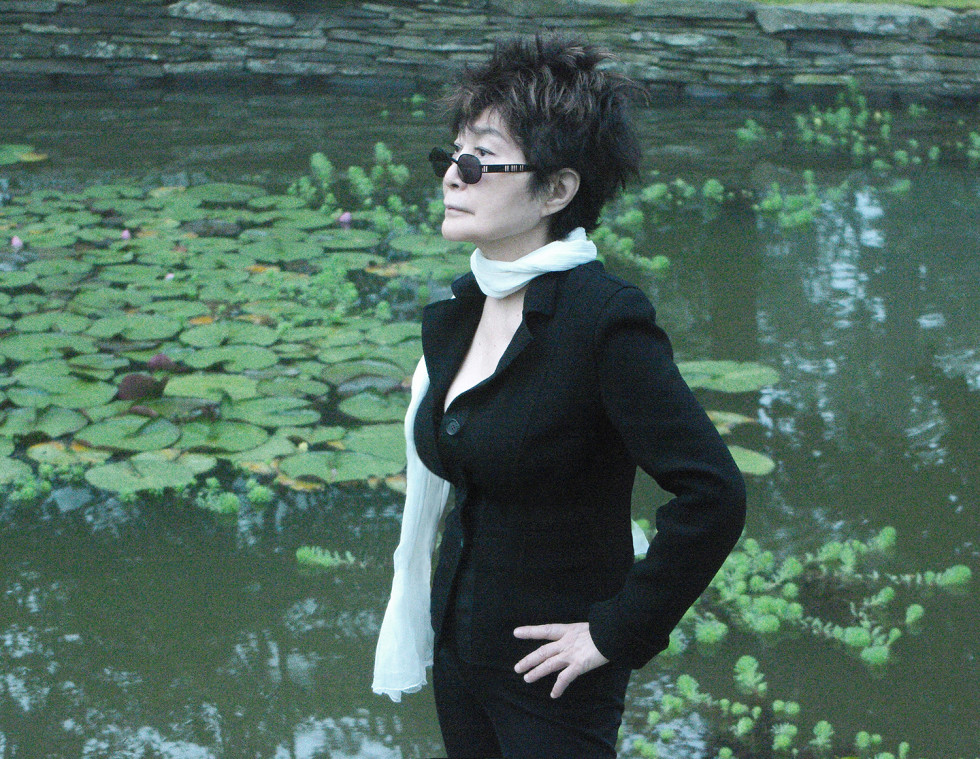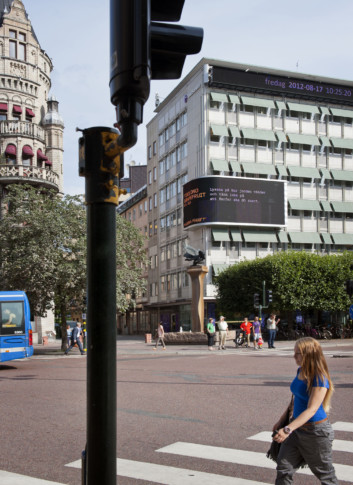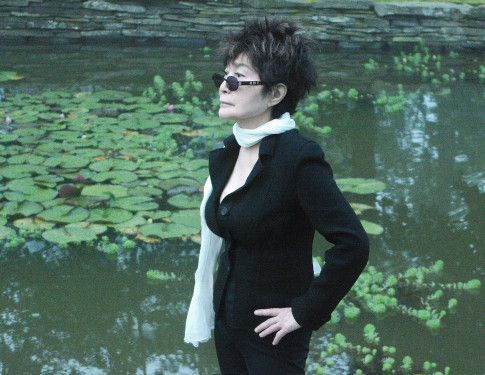
Yoko Ono, 2009 Photo by Synaesthete, 2009
Grapefruit – Idea as Art
Text: Cecilia Widenheim
In the 1950s, Yoko Ono had already begun experimenting in the borderland between music, performance, poetry and visual art. She used the concert and event formats as a place where the audience was encouraged to enact her ideas, or simply to think and develop them in their own minds. With a background in classical music composition and studies in philosophy, Yoko Ono began writing “scores” for art, that is, instructions that could be interpreted again and again by audiences and colleagues. In each new context, new expressions and nuances arise, depending on who is doing it and where. One of Yoko Ono’s most famous instructions is Cut Piece from 1964, which the artist herself has performed on several occasions. The enacted situation consists of Yoko Ono sitting on a stage before an audience, with a pair of scissors in front of her, inviting the audience to cut pieces from her clothing.
In recent years, Yoko Ono’s work has been featured in various contexts in Sweden. This exhibition highlights the book Grapefruit, which Yoko Ono self-published in Japan in 1964. The book is a collection of texts, so-called instruction pieces, and has been reprinted in many editions over the years. The texts can be described as short instructions for making paintings, events, objects, music and films. Grapefruit is a collection of suggestions for works of art – ideas that can be carried out, or simply take shape in the viewer’s imagination, revealing the poetry of trivial everyday things and rituals. Grapefruit is a book about the power of thought and the art of becoming. In the 1960s, Yoko Ono emerged as an influential artist on the New York avant-garde scene and in the Fluxus movement. Since then, she has also been a peace activist, and musician and composer. Over the past 15 years, more and more museums around the world have had an increased interest in her work, starting with the major retrospective YES YOKO ONO, which featured nearly 50 years of groundbreaking creativity.
Neither East nor West
When asked why the book is called Grapefruit, Yoko Ono has often referred to the popular notion of the grapefruit as a hybrid between a lemon and an orange, and this hybrid as a metaphor for her own identity. Yoko Ono was born in Japan in 1933 but moved back and forth between Japan and the USA with her family throughout the 1940s, while the Second World War shook the relationship between East and West. Yoko Ono was one of very few women artists in the circle where conceptual art developed around 1960. Her legendary series of loft concerts on Lower Manhattan attracted fellow-artists such as John Cage, David Tudor, La Monte Young and Marcel Duchamp. She built an enticing platform for her work on the avant-garde scenes of New York, Tokyo and London, long before she met John Lennon, with whom she lived until his death in 1980. Yoko Ono’s artistic voice oscillates sharp wit and haiku poetry that encourages contemplation, and like few others she has succeeded to create an interesting dialogue between the Eastern and Western avant-garde.
Film as state of mind, event and action
Yoko Ono’s films have a unique position in the field of 1960s experimental film-making. Several of them are based on instructions published in Grapefruit – for instance, the film No. 1 (Match), which is based on the text Lighting Piece from autumn 1955: “Light a match and watch till it goes out.” Another example is the work Fly, which has been implemented in various media, including film. Yoko Ono operates on several levels with film as a state of mind and performance, rather than as a traditional narrative with a beginning and an end. She also utilised film as an instrument for contemporary political discussions on women’s liberation, the Vietnam War and the peace movement. Ono’s film works often centre on themes such as the body, time, vulnerability and activism, and are occasionally referred to as erotic conceptualism. When the major exhibition WACK! Art and the Feminist Revolution toured the USA a few years ago, several of her films were featured as examples of how women artists used the body as an artistic medium aimed at exploring and twisting the classic polarity between subject and object.
A dialogue between sender and viewer
Grapefruit has continued to inspire new generations of readers, and especially new generations of artists who are interested in process and idea based art, and practices based on scores and instructions. For the exhibition at Moderna Museet, Yoko Ono has written a new instruction, Search for the Fountain. The text has been sent to some 20 artists who have been invited to respond to, and comment on, the text in various ways. The fountain is a recurring metaphor in Yoko Ono’s oeuvre, symbolising a source or something that is in perpetual motion and produces a very specific sound. Perhaps we can even sense a link to concept of Fluxus (Latin for flow), and to the international art movement that Yoko Ono is often associated to, and which developed an entirely new approach to the concept of art in the 1960s. Search for the Fountain is a distinct example of how Yoko Ono intentionally lets the materialisation of her artistic ideas lie open to interpretation, but also how she assumes that viewers will handle and reinterpret the concept from their own perspectives.


